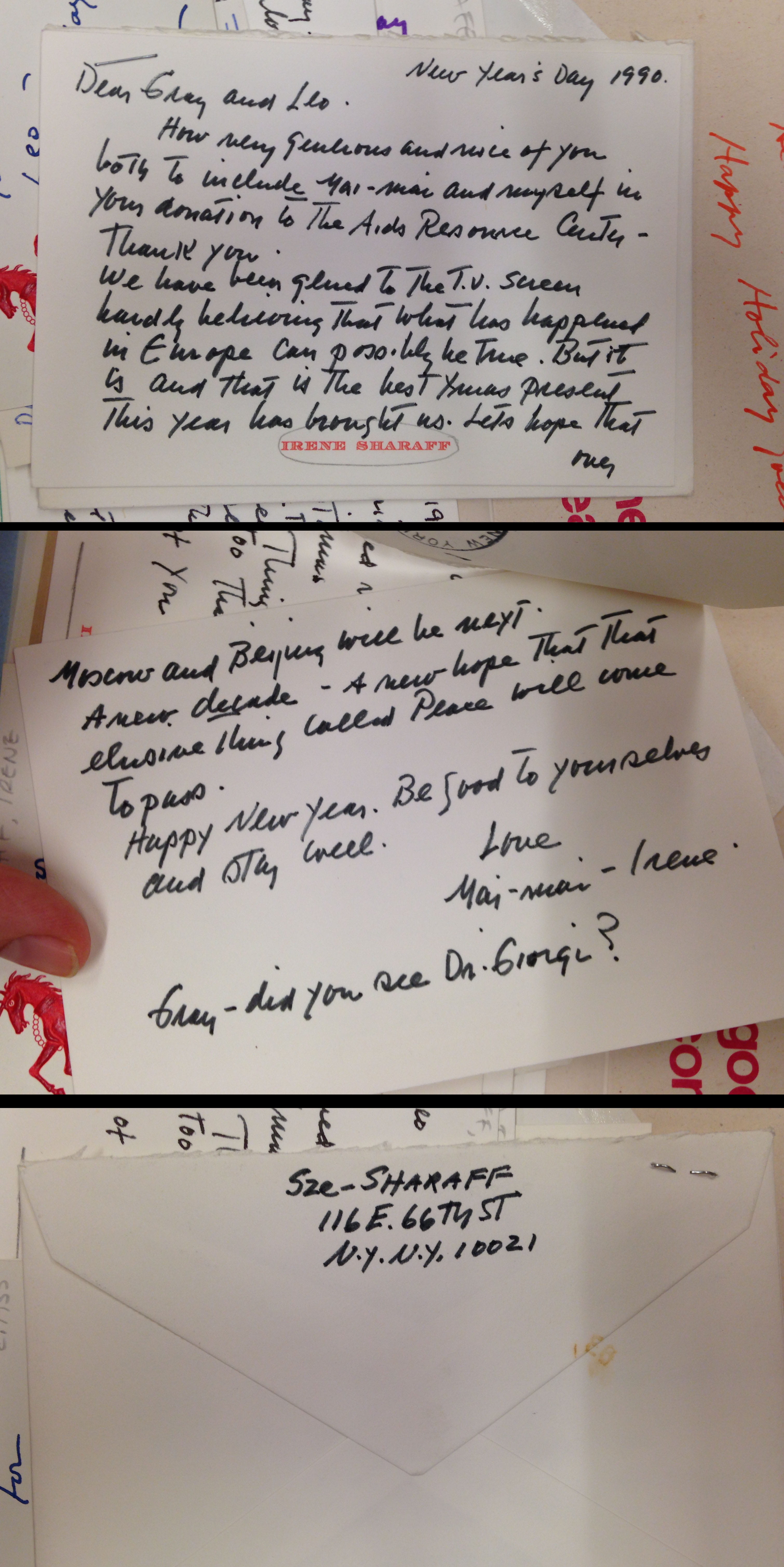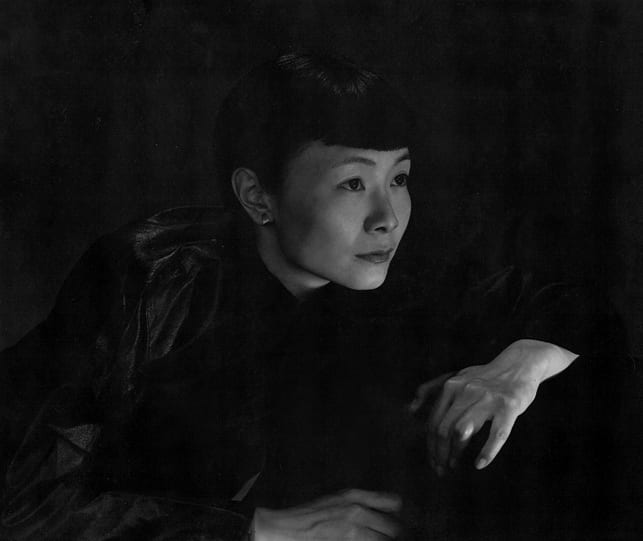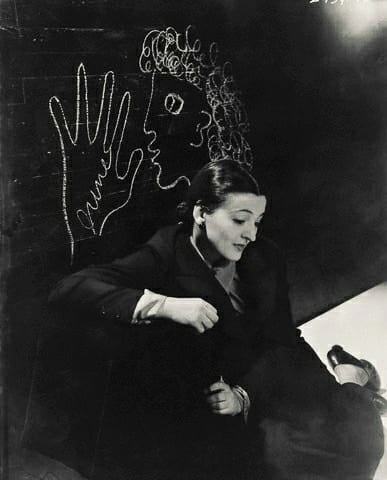by contributing editor Erin McGuirl
I’ve written about Mai-mai Sze on this blog three times, and in those pieces I have focused on her life as a reader and writer. I am neither a historian nor a biographer by training – I’m a librarian – but I think that I must acknowledge a responsibility to Sze as her amateur biographer because I have written most about her. Up to now I have felt no real urgency to discuss Sze’s life-long partnership with Irene Sharaff. While neither makes mention of their relationship in the work for which they are known, glimpses of their private life together survive in the fragments of correspondence that remain in the archives and the memories of those who knew them. Although we can ignore the fact that Sharaff and Sze had a same-sex relationship when considering their work, exploring how they might have shaped each other’s lives and legacies adds depth and nuance to the story of how they made it.
From the mid-1930s until her death, Mai-mai Sze and the costume designer Irene Sharaff were a devoted couple; every person I’ve interviewed about Sze has used that word to describe the relationship. They lived together in New York in an apartment on 66th Street, and Sze always accompanied Sharaff to filming locations in Hollywood and all over the world. We find evidence of this in Sze’s correspondence, and even in her reading. Many books survive with loose sheets of notes written on stationery from the Beverly Hills Hotel, and her surviving correspondence often describes her travels with Sharaff. Sharaff’s letters make frequent mentions Sze, and they often signed letters to friends together. Jeannette Sanger, the owner of the now-closed Books & Co., described how the couple always appeared together not only at the store but also at literary parties. They were inseparable and their love and admiration for one another was apparent to everyone who knew them. Despite the fact that they were well-known as a couple, however, neither makes any mention of the other in their published work. Both Sze and Sharaff published autobiographies: Sze’s covers her childhood, and Sharaff exclusively writes on her work as a designer. Neither mentions the other anywhere in the texts. In both women, we find an intense separation between the person they presented to the public, and private life they lived together.
While we cannot confidently use the word lesbian to describe either the women themselves or their relationship because we just don’t know if either identified as such, I think that the Sharaff-Sze story can be read as lesbian history, and that ways of looking at lesbian life can shed light on both women’s lives as individuals. Sharaff and Sze’s relationship exhibits many of the “subliminal signs that we read as lesbian” described by Frances Doughty in her article, “Lesbian Biography, Biography by Lesbians.” They were “intimate woman companions who … shared housing and daily life;” both were engaged in “a self-defined work that is a central theme in the subject’s life” (Sharaff’s work in film and theater in New York and Hollywood, which have historic connections to LGBT communities, deserves mention here); Sze maintained an “active interest in and struggles on behalf of other oppressed or deviant groups;” and the couple had friendships with gay men, most notably Leo Lerman and Gray Foy. (Doughty, 78) Their relationship also fits Lillian Faderman’s definition of lesbian relationships, as both private records and anecdotes of those who knew them firmly establish that their “strongest emotions and affections [were] directed toward each other.”

Letter from Sharaff and Sze to Leo Lerman and Gray Foy, January 1, 1990 (author’s photo; Leo Lerman Papers; Box 19; courtesy of the Rare Book and Manuscript Library, Columbia University Library)
Examining their lives within the context of lesbian history, we can begin to understand why Sharaff and Sze’s private selves are so different from their public selves. Both women came of age in the late 1920s and ’30s, times that saw a major shift in the perception of lesbianism in America. While the ’20s were a time of greater sexual freedom across the general population because of the mainstream acceptance of Freudian psychology, it was also the first time that lesbianism was described as a disease. In the 1930s, the idea of homosexuality as an illness was broadly accepted across the medical community and also in some areas of popular culture, like pulp fiction and the theater. Times continued to change, and throughout their lives these women witnessed seismic shifts in perceptions of homosexuality.

Mai-mai Sze (1909-1992), c. 1940 by George Hoyningen-Huene
Throughout most of their adult lives and particularly at a time when both women were taking a firmer foothold in their careers in the 1950s, any public admission of their private relationship – however they would have defined it – may have had a harmful effect on their success. It seems reasonable to suggest that the McCarthy era witch-hunts for homosexuals in the 1950s would have worried them, particularly because so many of Sharaff’s colleagues were targeted in Hollywood. Whether or not they wanted to live publicly as a loving couple, obscuring the details of their relationship may have been one way of ensuring that they achieved their personal goals.
In their private lives, however, Sharaff and Sze’s relationship facilitated the achievements which defined their public personas. Throughout much of the twentieth century, women chose same-sex relationships for many reasons, one of which was the freedom that their choice allowed them. By rejecting the traditionally female roles of wife and mother, women like Mai-mai Sze and Irene Sharaff gave themselves the time, and the emotional and intellectual support they needed to reach a level of professional success that would have been unthinkable for most straight women of their generation. Sharaff and Sze’s shared life and their devotion to one another gave them the freedom to pursue their self-defined creative, intellectual, and professional goals.
In their public selves, Sharaff and Sze did not enjoy the same level of success, despite the fact both were equally devoted to the work they chose for themselves. Sharaff was a hugely successful costume designer who was nominated for eleven Academy and nine Tony Awards, five of which she won. A feminist reading of this situation would suggest that nature of her public successes allowed Sharaff to embody male values of achievement in her career, and she was rewarded by the male-dominated entertainment business. As I’ve previously written, Mai-mai Sze appears to have been so devastated by James Cahill and Nelson Wu’s rejection of her first published book that she spent the rest of her life trying to rebuild her confidence as a thinker and translator, and never published another word. In contrast to Sharaff, a white woman whose a profession as a costume designer was judged as suitable for her gender, Sze was thwarted in her scholastic career. It is in her heavily annotated books, however, that we see that she never stopped working. Sze the reader remained dedicated to study and scholarship until her death.

The Music and Meditation Pavilion at Lucy Cavendish College, built following a donation by Sharaff and Sze. The two never visited Lucy Cavendish, but their ashes rest under two halves of the same rock beside the Pavilion’s entrance.
Irene Sharaff lived for only eleven months after Mai-mai Sze died in 1992, but in that time she saw to the deposit of her partner’s books at the Society Library. The gift can be read as Sze’s final presentation of her public self, and Sharaff’s part in it beautifully illustrates how she supported Sze’s vision of it. There’s no doubt that we must continue to look carefully at the work these wanted to be remembered for, and in recognizing that work, we can also honor private ways that Sharaff and Sze helped one another to live, doing the work they loved together.
Many thanks to Elizabeth Ott, whose criticism greatly improved this piece.




May 17, 2016 at 7:14 am
Lovely piece. I worked at the NYSL in the late 90s and there were still people who remembered them well.
March 10, 2017 at 12:05 pm
An excellent piece. It is very much how I remember them.They were both friends of my parents in Hollywood and i remember them well.I was a child at the time,but they treated me as someone who mattered (not the usual way with children in those days) I particularly remember Mai Mai – she was exquisite. I still have her autobiography , which she gave me, with a lovely inscription and a little drawing
October 4, 2017 at 12:22 pm
Beautiful writing! I Did her hair few time in the 1990s, Ms Sharaff, Beautiful and kind person
August 6, 2018 at 7:34 am
I felt very moved and admired by the life of these women so devoted to each other. Thank you for this beautiful text
March 21, 2019 at 6:55 am
Hello,it is such a pleasure to read your article. I am a visiting scholar in SOAS, and I am working on Maimai Sze and her translation of that painting manual. I feel like I need to buy you a coffee and talk to you if possible. Is it possible that we could talk?
March 15, 2021 at 10:07 pm
Thank you for these insights about two creative women I’ve just discovered watching the film, Midnight Lace. My heart feels good that they lived the lives they wanted, given the constraints of the times. What a remarkable person each of them was! Karin in Toronto